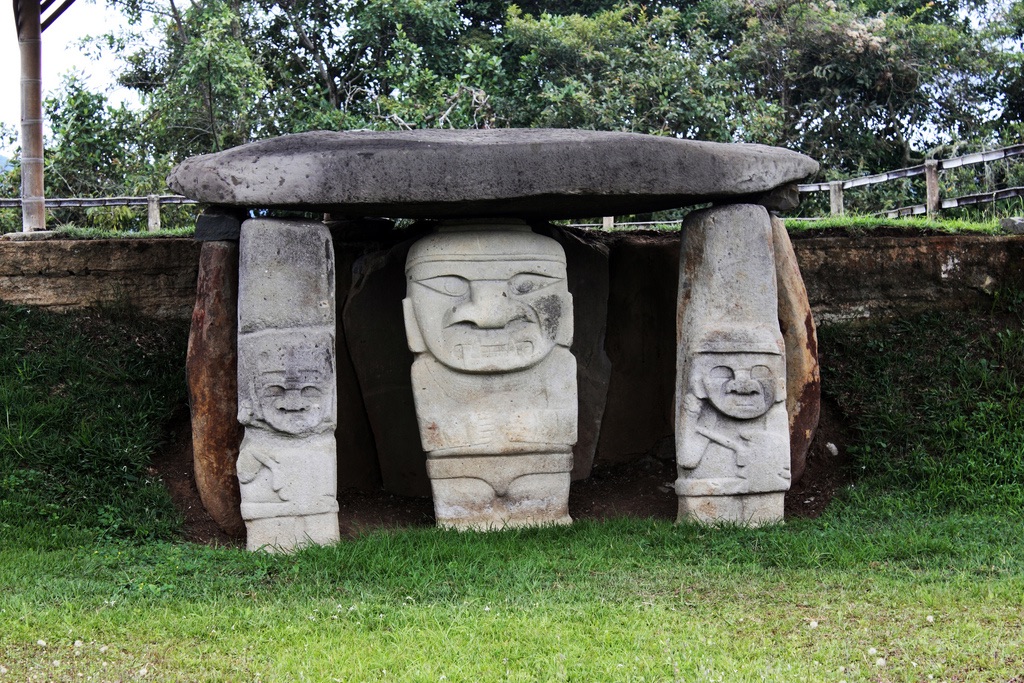Nestled in the Andean foothills of Colombia, the San Agustin Archaeological Park is a treasure trove of ancient mysteries. This UNESCO World Heritage site boasts the largest collection of religious monuments and megalithic sculptures in South America. These artifacts date back to the 1st to the 8th century AD, offering a glimpse into a pre-Columbian civilization that once thrived here. The park spans over 2,000 hectares and includes ceremonial centers, burial mounds, and over 500 monolithic statues, some towering over seven meters high. The intricate carvings and designs on these statues provide invaluable insights into the beliefs, rituals, and cosmology of the ancient San Agustín culture.
San Agustín culture
The San Agustín culture, flourishing from 3300 BC to 1550 AD in what is now the Huila Department of southwestern Colombia, remains one of the most enigmatic pre-Columbian civilizations in South America. This culture is renowned for its monumental religious sculptures and complex funerary practices, which have captivated historians and archaeologists alike. The timeline of San Agustín spans over several millennia, showcasing a civilization that developed sophisticated societal structures and artistic expressions long before the arrival of European explorers.
One of the major moments in the history of the San Agustín culture was the construction of their elaborate ceremonial centers and burial sites. These sites, which date from the 1st to the 8th century CE, are adorned with large stone sculptures depicting gods, mythical animals, and human figures. The largest collection of these sculptures can be found in the San Agustín Archaeological Park, a UNESCO World Heritage site. These monuments provide critical insights into the religious beliefs and practices of the San Agustín people, highlighting a civilization deeply engaged in spiritual and ritualistic activities.
Religion played a central role in the San Agustín culture, with a pantheon of deities that governed natural elements and aspects of human life. The intricate carvings and statues found throughout the region suggest a belief system that venerated both anthropomorphic and zoomorphic figures, indicating a complex mythology that intertwined human and animal characteristics. These religious beliefs were closely linked to agricultural cycles, celestial events, and the afterlife, reflecting a deep connection between the San Agustín people and their environment.
The social and daily life of the San Agustín culture, though not fully understood, is believed to have been organized in small, autonomous communities. These communities were likely governed by a class of religious leaders or shamans, who oversaw spiritual practices and rituals. The economy was primarily based on agriculture, with maize being a staple crop, supplemented by hunting and fishing. The craftsmanship of the San Agustín people was remarkable, not only in their monumental sculptures but also in their pottery, goldwork, and textiles.
There is little concrete evidence regarding the rulers, kings, or queens of the San Agustín culture. The absence of written records makes it challenging to ascertain the political structure or identify individual leaders. However, the scale and complexity of the ceremonial centers and burial sites suggest a society with a well-defined social hierarchy, possibly ruled by a priestly class or a dynastic lineage of leaders.
The origins of the San Agustín culture are still a subject of research and debate among scholars. It is believed that they were descendants of earlier nomadic groups that settled in the region, gradually developing the agricultural practices and societal structures that characterized their civilization. The isolation of the San Agustín culture, surrounded by dense forests and rugged terrain, likely contributed to the unique development of their artistic and religious traditions.
There is scant evidence of wars or battles involving the San Agustín culture. The geographical isolation of the region may have shielded them from external conflicts, allowing their civilization to develop relatively undisturbed. However, the decline of the San Agustín culture around the 8th century CE remains a mystery, with theories ranging from environmental changes to internal social upheaval.
In conclusion, the San Agustín culture represents a fascinating chapter in the pre-Columbian history of South America, marked by its monumental sculptures, complex religious beliefs, and sophisticated societal organization. Despite the many unknowns surrounding their civilization, the legacy of the San Agustín people continues to intrigue and inspire, offering a glimpse into a world that existed in harmony with nature and the cosmos.

